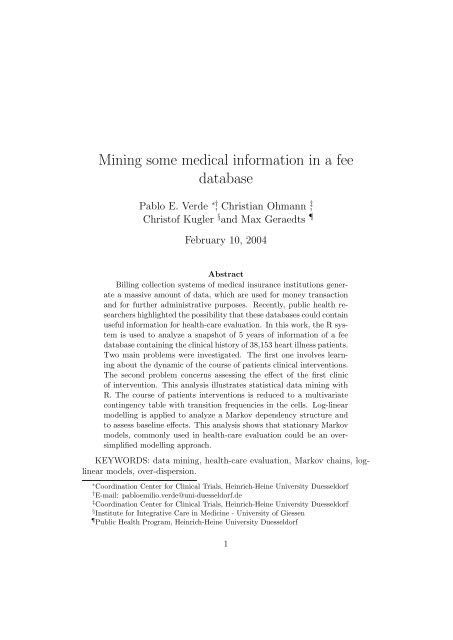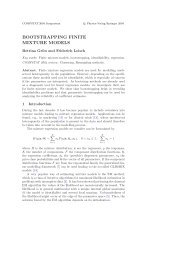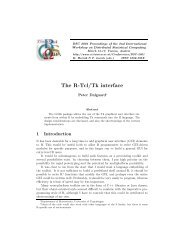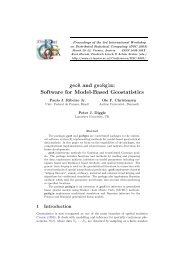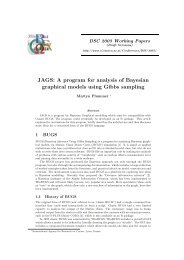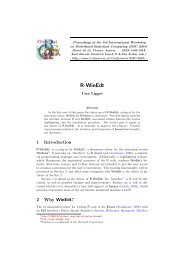Embedding R in Windows applications, and executing R remotely
Embedding R in Windows applications, and executing R remotely
Embedding R in Windows applications, and executing R remotely
You also want an ePaper? Increase the reach of your titles
YUMPU automatically turns print PDFs into web optimized ePapers that Google loves.
M<strong>in</strong><strong>in</strong>g some medical <strong>in</strong>formation <strong>in</strong> a fee<br />
database<br />
Pablo E. Verde ∗† , Christian Ohmann ‡ ,<br />
Christof Kugler § <strong>and</strong> Max Geraedts <br />
February 10, 2004<br />
Abstract<br />
Bill<strong>in</strong>g collection systems of medical <strong>in</strong>surance <strong>in</strong>stitutions generate<br />
a massive amount of data, which are used for money transaction<br />
<strong>and</strong> for further adm<strong>in</strong>istrative purposes. Recently, public health researchers<br />
highlighted the possibility that these databases could conta<strong>in</strong><br />
useful <strong>in</strong>formation for health-care evaluation. In this work, the R system<br />
is used to analyze a snapshot of 5 years of <strong>in</strong>formation of a fee<br />
database conta<strong>in</strong><strong>in</strong>g the cl<strong>in</strong>ical history of 38,153 heart illness patients.<br />
Two ma<strong>in</strong> problems were <strong>in</strong>vestigated. The first one <strong>in</strong>volves learn<strong>in</strong>g<br />
about the dynamic of the course of patients cl<strong>in</strong>ical <strong>in</strong>terventions.<br />
The second problem concerns assess<strong>in</strong>g the effect of the first cl<strong>in</strong>ic<br />
of <strong>in</strong>tervention. This analysis illustrates statistical data m<strong>in</strong><strong>in</strong>g with<br />
R. The course of patients <strong>in</strong>terventions is reduced to a multivariate<br />
cont<strong>in</strong>gency table with transition frequencies <strong>in</strong> the cells. Log-l<strong>in</strong>ear<br />
modell<strong>in</strong>g is applied to analyze a Markov dependency structure <strong>and</strong><br />
to assess basel<strong>in</strong>e effects. This analysis shows that stationary Markov<br />
models, commonly used <strong>in</strong> health-care evaluation could be an oversimplified<br />
modell<strong>in</strong>g approach.<br />
KEYWORDS: data m<strong>in</strong><strong>in</strong>g, health-care evaluation, Markov cha<strong>in</strong>s, logl<strong>in</strong>ear<br />
models, over-dispersion.<br />
∗ Coord<strong>in</strong>ation Center for Cl<strong>in</strong>ical Trials, He<strong>in</strong>rich-He<strong>in</strong>e University Duesseldorf<br />
† E-mail: pabloemilio.verde@uni-duesseldorf.de<br />
‡ Coord<strong>in</strong>ation Center for Cl<strong>in</strong>ical Trials, He<strong>in</strong>rich-He<strong>in</strong>e University Duesseldorf<br />
§ Institute for Integrative Care <strong>in</strong> Medic<strong>in</strong>e - University of Giessen<br />
Public Health Program, He<strong>in</strong>rich-He<strong>in</strong>e University Duesseldorf<br />
1


